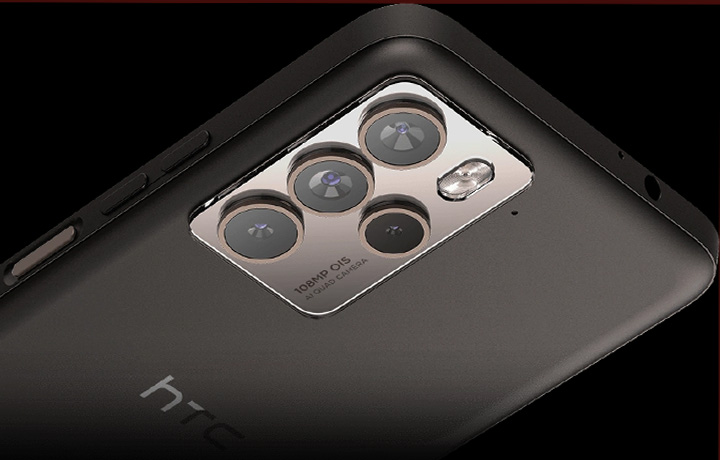HTC U23 Pro Review – Nostalgic Appeal with Room for Improvement
In an industry that has long been dominated by smartphone giants, HTC’s return with the U23 Pro has been nothing short of intriguing. Once a formidable player in the smartphone world, HTC has taken a backseat in recent years. With the U23 Pro, HTC hopes to make a resurgence in the mid-range smartphone market.
In this in-depth review, we will inspect closely and thoroughly every facet of the HTC U23 Pro, from its design and display to its performance, camera capabilities, and more, to determine if it has the potential to stand out in a fiercely competitive landscape. Check out the latest price of HTC U23 Pro here>
- Read also:
- Tecno Spark 10 Pro vs. Samsung Galaxy A34
- iPhone 14 Pro Max Review
- Asus Zenfone 10 vs. Samsung Galaxy S23
Design and Build Quality
The HTC U23 Pro arrives as a mid-range smartphone, equipped with the kind of specifications one would expect. However, what truly catches the eye here is its 120Hz OLED display and an impressive 108-megapixel camera with optical image stabilization (OIS).
Adding to its appeal is the HTC brand name, which, much like Nokia, evokes a sense of nostalgia for the golden days of mobile phones. The device boasts a soft, velvety finish with a subtle metallic sheen, but it does have a tendency to attract smudges. Despite opting for plastic materials, the U23 Pro manages to feel sturdy in hand.
Notably, HTC has thoughtfully included Ingress Protection rated at IP67, a valuable feature typically reserved for more premium devices. Additionally, the presence of an RGB notification LED, which was once all the rage but has since become a rarity, adds a touch of old-school charm to the phone. Check out the latest price of HTC U23 Pro here>
Display
The HTC U23 Pro boasts a 6.7-inch OLED display with a 1080p resolution and an impressive 120Hz refresh rate. This display is nothing short of a visual treat. It delivers sharp, vivid visuals, with colors that pop, regardless of the chosen color mode.
However, it’s important to note that the U23 Pro lacks support for High Dynamic Range (HDR) video, which is now expected in most mid-range and flagship devices. Additionally, one can’t help but notice the relatively thick bezels surrounding the screen.
While the display’s maximum brightness reaches a decent 725 nits using manual adjustment, it doesn’t get any brighter when the auto mode is enabled. The high refresh rate adds a layer of smoothness to navigating the user interface and scrolling through content, although it’s worth mentioning the slightly thick bezels.
- iPhone 14 Pro Max Review
- Asus Zenfone 10 vs. Samsung Galaxy S23 – A Compact Showdown
- Elevate Your Smartphone Videography with the Top Three Gimbals
Audio and Fingerprint Scanner
HTC deserves credit for retaining a headphone jack, a feature that’s been disappearing from many modern smartphones. The audio output, delivered through a single bottom-firing speaker, is commendably loud and maintains good audio quality. However, there’s room for improvement, especially when considering the competition.
Unlocking the HTC U23 Pro is a breeze with the side-mounted fingerprint scanner, neatly integrated into the power button. While it offers convenience, it’s worth noting that it may not be the most accurate option available. Additionally, the unlock animation could use some optimization for smoother and quicker unlocking.
Performance and Software
Under the hood, the HTC U23 Pro is powered by a Snapdragon 7 Gen 1 chipset. While this chipset is relatively new as of last year, it doesn’t deliver groundbreaking performance. The U23 Pro manages to hold its own in benchmark tests, staying competitive with other mid-range smartphones. In daily usage, the device feels relatively smooth, thanks in part to its near-stock Android 13 interface.
HTC’s decision to embrace a near-stock Android experience is a commendable choice. The interface feels clean and minimalistic, adhering to the simplicity that many users appreciate. Most elements of the interface are standard, with a few minor tweaks here and there.
For example, the task switcher includes a screenshot button instead of a clear-all button, a minor change that might take some getting used to. HTC has also included a handful of pre-installed apps, but they are thoughtfully organized within a folder, making them easy to ignore or uninstall if they don’t align with your preferences.
Thermal Performance
When subjected to prolonged stress tests, the HTC U23 Pro’s CPU showed signs of significant throttling. This resulted in a nearly 50% reduction in its performance, bringing it down to a level comparable to the Snapdragon 685.
This level of thermal throttling could disappoint gaming enthusiasts who expect consistent and sustained performance during extended gaming sessions.
Battery Life and Charging
The U23 Pro is equipped with a 4600mAh battery. However, its endurance rating of just 83 hours in our tests falls behind the performance of many other mid-range smartphones. Here, HTC has followed a growing trend by not including a charger in the package. While this decision aligns with an effort to reduce e-waste, it means that users will need to provide their own charger.
The device does support 30W fast charging, and with the appropriate adapter, it can charge from zero to sixty percent in just half an hour. This charging speed is respectable and should help users quickly get their device back up to speed when needed. Check out the latest price of HTC U23 Pro here>
- Shop On Amazon Using Our Links To Support Us:
- My pixel 7 Pro Case here
- Amazon under $25:
- Amazon best sellers
- Amazon most gifted
Camera Performance
The HTC U23 Pro’s camera setup is worth discussing, as it includes some noteworthy features. The primary camera boasts an impressive 108-megapixel resolution, supported by optical image stabilization (OIS). Additionally, there’s an 8-megapixel ultra-wide camera, a 5-megapixel macro camera, and a dedicated depth sensor.
The primary camera captures photos at a default resolution of 12 megapixels, achieved through pixel binning. The results are decent but fall short of being truly impressive. While colors appear natural and pleasant, finer details often appear soft in many of the samples we captured. Additionally, the shots tend to be on the contrasty side, and the dynamic range could benefit from improvement. Dark shadows can lose detail, which is a drawback.
The two-times digital zoom from the primary camera delivers reasonably good results, maintaining a similar level of quality to regular photos. Portrait mode photos, however, leave room for improvement. Subject detection and separation, despite the presence of a dedicated depth sensor, are not as precise as expected.
In low-light conditions, photos from the main camera exhibit notable noise and softness. Contrast is excessively high, leading to issues with handling light sources and highlights, which often end up blown out or clipped. The camera does offer a dedicated night mode that can be toggled on, which helps reduce noise and improve brightness. The trade-off is a reduction in contrast, and better handling of light sources and highlights.
Moving to video capabilities, the primary camera is capable of recording in 4K resolution. Videos produced by the camera exhibit good detail and minimal noise. However, the colors could be more vibrant, and you may encounter instances of dark shadows and blown-out highlights. It’s worth noting that electronic stabilization is available, but only up to 1080p resolution, and it’s not perfect, occasionally resulting in some shakiness.
Ultra-Wide Camera
The HTC U23 Pro’s ultra-wide camera, which often complements the primary camera, delivers decent results. Photos exhibit an acceptable level of detail and a reasonably balanced dynamic range. However, noise is noticeable in the frame, and softness is evident, particularly around the edges of the images. Additionally, there is a reddish tint in the colors, which could impact the overall appeal of the photos.
In low-light conditions, the ultra-wide camera struggles. Photos taken in these settings tend to be noisy and soft, with light sources often blown out. Activating night mode when using the ultra-wide camera significantly improves the situation, resulting in better detail and improved handling of light sources. Nevertheless, it’s important to note that the ultra-wide camera can capture videos in 1080p resolution. While these videos are serviceable, they bear a noticeable red tint, and softness, especially around the corners, remains a concern.
Macro Camera
A pleasant surprise in the HTC U23 Pro’s camera setup is the dedicated macro camera. This camera impressively captures close-up shots, delivering vibrant colors and remarkable detail. It’s a valuable addition for users who enjoy exploring the world of close-up photography.
Selfie Camera
The U23 Pro is equipped with a 32-megapixel selfie camera. However, photos taken with this camera default to 8-megapixel images, thanks to pixel binning. Selfies from this camera boast pleasing colors and skin tones. The level of detail and texture in facial features is acceptable, although there is room for improvement to achieve even sharper results.
- Mastering Google Pixel 7 Pro Camera Settings: Tips and Tricks
- 14 Essential Tips and Tricks For Google Pixel 7 Pro
- Hohem Go AI-Based Auto Tracking Holder Review: Your Pocket-Sized Camera Operator
Conclusion
The HTC U23 Pro’s standout features include its nostalgic design, waterproofing capabilities, and a delightful 120Hz AMOLED display. The device is powered by a decent chipset and retains some valuable features, such as a headphone jack and an RGB notification LED. However, it’s essential to address the phone’s shortcomings, which are not insignificant.
The U23 Pro’s single speaker falls short of the audio quality offered by competitors. The device’s battery life, despite the 4600mAh battery, is unimpressive, earning it an endurance rating that lags behind that of many mid-range smartphones. It’s notable that HTC has followed the trend of not including a charger in the box, which may inconvenience some users.
The camera performance, despite the impressive-sounding 108-megapixel main camera with OIS, leaves much to be desired. Default photos, achieved through pixel binning, are decent but lack the wow factor. Low-light photography, in particular, suffers from noise and softness. While night mode improves the situation, it’s not a game-changer. The ultra-wide camera and selfie camera perform adequately but struggle in challenging conditions.
Considering the HTC U23 Pro’s higher price point in the mid-range category, it faces tough competition. Alternatives such as Samsung’s Galaxy A54 and Xiaomi’s Poco F5 offer a more balanced package of features and performance. While HTC’s attempt to rekindle nostalgia is commendable, it falls short in several key areas, making it challenging to recommend this device over its competitors.
In conclusion, the HTC U23 Pro shows promise and evokes fond memories of the brand’s past glories. However, it fails to meet the high standards set by current mid-range smartphones, leaving room for improvement in various aspects. As HTC endeavors to stage a comeback, the U23 Pro serves as a stepping stone, reminding us of the brand’s legacy but also highlighting the need for innovation and excellence to thrive in today’s highly competitive smartphone landscape. Check out the latest price of HTC U23 Pro here>
- Shop On Amazon Using Our Links To Support Us:
- My pixel 7 Pro Case here
- Amazon under $25:
- Amazon best sellers
- Amazon most gifted






